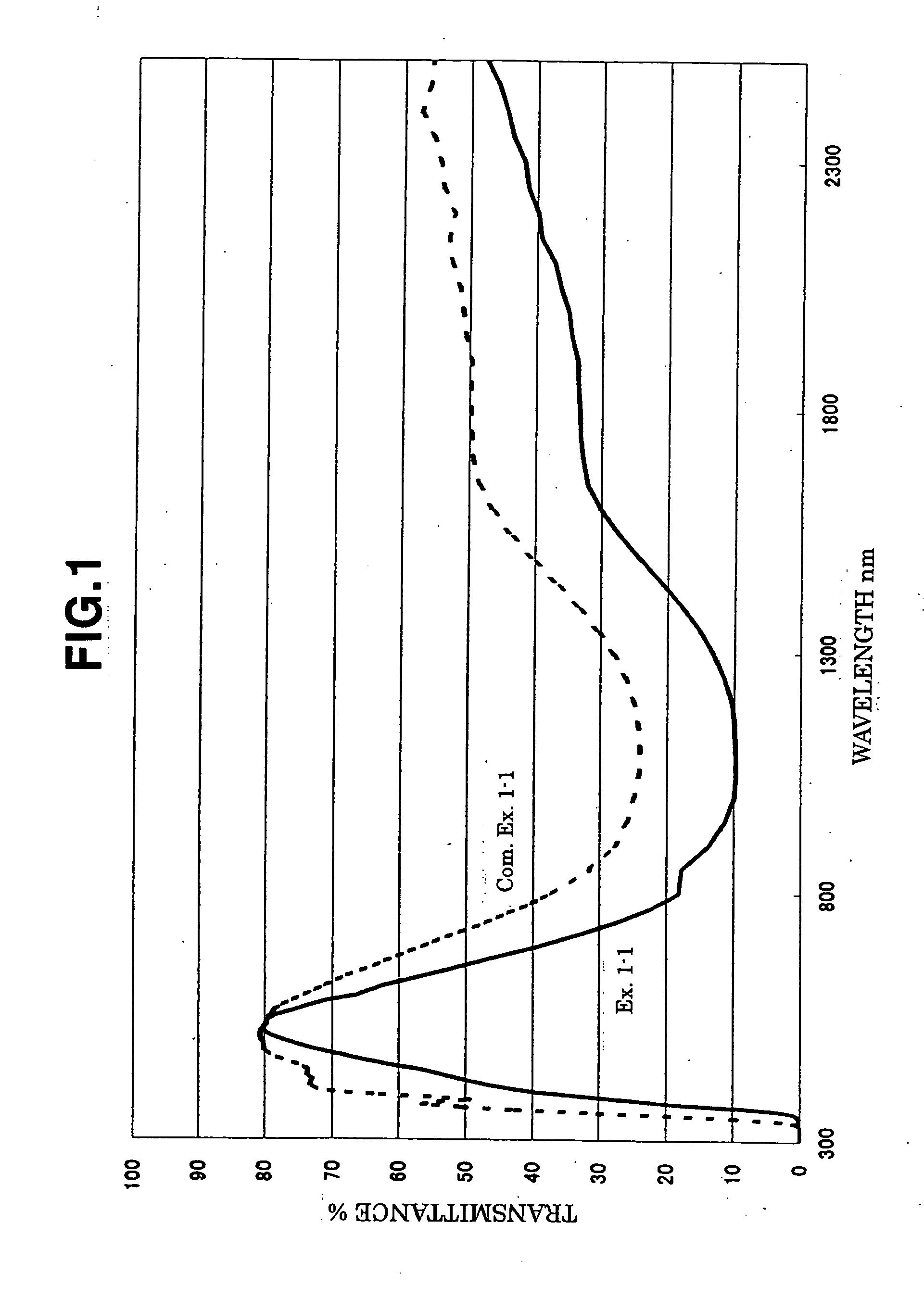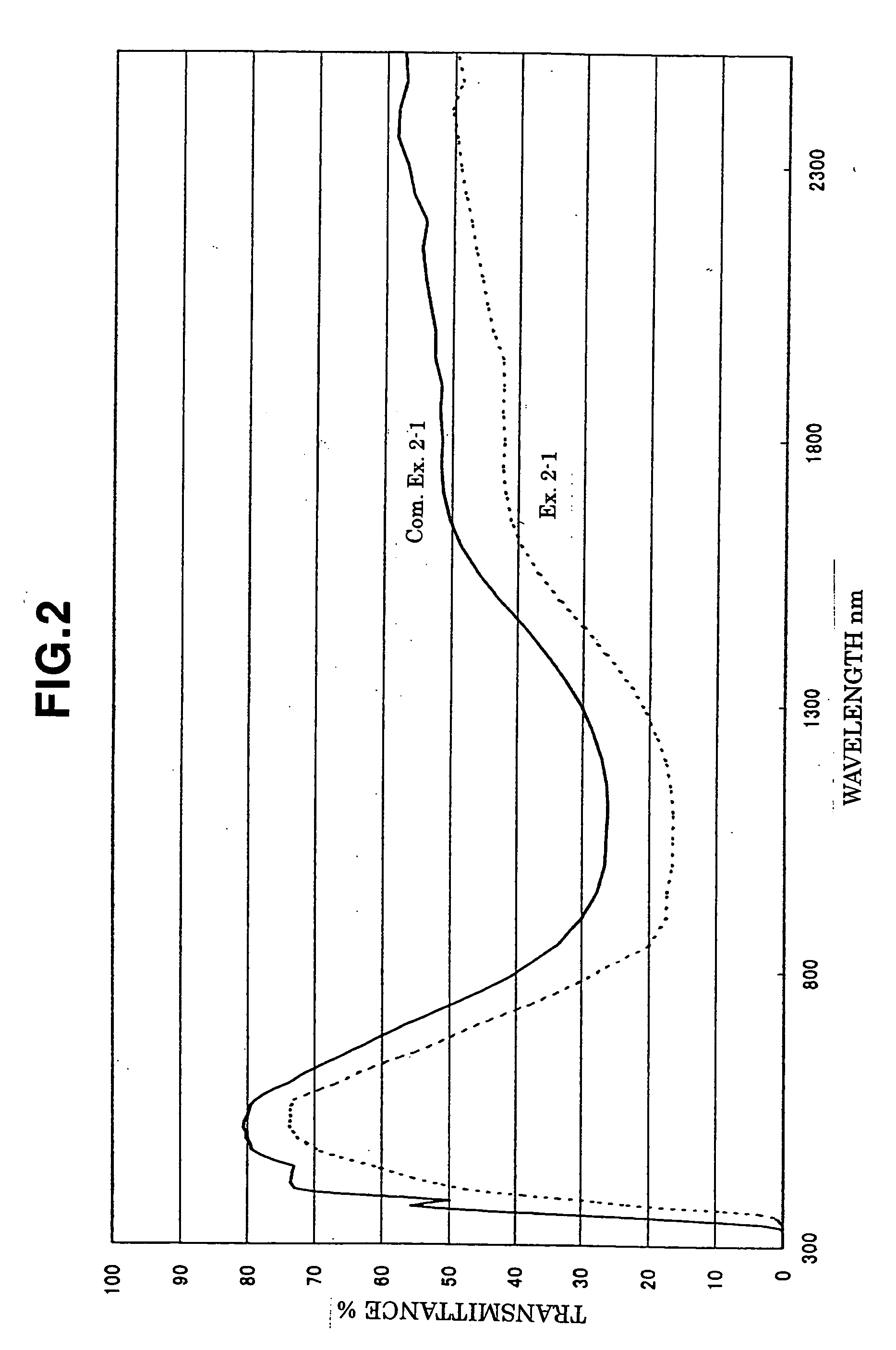Ultraviolet and infrared absorptive greenish glass
- Summary
- Abstract
- Description
- Claims
- Application Information
AI Technical Summary
Benefits of technology
Problems solved by technology
Method used
Image
Examples
example 1-1
[0059] As glass raw materials, there were used silica sand, feldspar, soda ash, dolomite, limestone, mirabilite, rouge, titanium oxide, and cerium carbonate. Furthermore, there were also used chemical reagents of Al2O3, Fe2O3, CaCO3, MgCO3, Na2CO3, K2CO3, CeO2 and TiO2, in addition to ilmenite, carbon and slug. Using these, a predetermined glass composition was previously set as a target composition, and they were weighed and mixed together. As a raw material batch, mirabilite / (silicon sand+feldspar) was adjusted to about 1%, and cutlet was adjusted to about 50%.
[0060] The mixed raw material was put into a crucible. It was melted for about 3-4 hours for vitrification in an actual furnace (for example, a wall portion on a lateral side of an inlet, a side wall portion of a condition portion), which was maintained at about 1450° C., or in an electric furnace made to be similar to the actual furnace while using nitrogen gas or a mixed gas containing the gas or the like. Furthermore, it...
example 1-2
[0064] Using glass raw materials almost similar to Example 1-1, an examination was continued by changing the glass composition. As a result, the glass composition was in weight expression 70.2% SiO2, 1.8% Al2O3, 8.2% CaO, 3.6% MgO, 12.7% Na2O, 0.9% K2O, 0.1% SO3, 0.32% total Fe2O3, 1.0% CeO2, 1.0% TiO2, and 13 ppm Cr2O3. FeO was in 0.15%. FeO / Fe2O3 was 0.47 in weight ratio expression. CeO2 / TiO2 was 1.0 in weight ratio expression. The total of
SiO2+Al2O3+Fe2O3+CaO+MgO+Na2O+K2O+SO3+CeO2+TiO2+Cr2O3+MnO was in 99.8%. SiO2+Al2O3+TiO2 was in 73.0%. CaO+MgO was in 11.8%. Na2O+K2O was in 13.8%.
[0065] The ultraviolet transmittance (Tuv) by ISO / DIS9050 at 5 mm thickness was in 8.5%. 350 nm wavelength transmittance (T350) was in 1%. 550 nm wavelength transmittance (T550) was in 79%. 1100 nm wavelength transmittance (T1100) was in 21%. The visible light transmittance (Tv) by A light source was in 75%. The solar radiation transmittance (Ts) was in 46%. The dominant wavelength (D) by D65 light ...
example 1-3
[0066] Using glass raw materials almost similar to Example 1-1, an examination was continued by changing the glass composition. As a result, the glass composition was in weight expression 69.5% SiO2, 1.6% Al2O3, 8.0% CaO, 3.7% MgO, 12.4% Na2O, 1.0% K2O, 0.1% SO3, 0.32% total Fe2O3, 1.4% CeO2, 1.9% TiO2, 7 ppm Cr2O3, 180 ppm MnO, and 0.2% SnO2. FeO was in 0.135%. FeO / Fe2O3 was 0.42 in weight ratio expression. CeO2 / TiO2 was 0.7 in weight ratio expression. The total of
SiO2+Al2O3+Fe2O3+CaO+MgO+Na2O+K2O+SO3+CeO2+TiO2+Cr2O3+MnO was in 99.9%. SiO2+Al2O3+TiO2 was in 73.0%. CaO+MgO was in 11.7%. Na2O+K2O was in 13.4%.
[0067] The ultraviolet transmittance (Tuv) by ISO / DIS9050 at 5 mm thickness was in 4.4%. 350 nm wavelength transmittance (T350) was in 0%. 550 nm wavelength transmittance (T550) was in 76%. 1100 nm wavelength transmittance (T1100) was in 20%. The visible light transmittance (Tv) by A light source was in 73%. The solar radiation transmittance (Ts) was in 46%. The dominant wave...
PUM
| Property | Measurement | Unit |
|---|---|---|
| Length | aaaaa | aaaaa |
| Fraction | aaaaa | aaaaa |
| Fraction | aaaaa | aaaaa |
Abstract
Description
Claims
Application Information
 Login to View More
Login to View More - R&D
- Intellectual Property
- Life Sciences
- Materials
- Tech Scout
- Unparalleled Data Quality
- Higher Quality Content
- 60% Fewer Hallucinations
Browse by: Latest US Patents, China's latest patents, Technical Efficacy Thesaurus, Application Domain, Technology Topic, Popular Technical Reports.
© 2025 PatSnap. All rights reserved.Legal|Privacy policy|Modern Slavery Act Transparency Statement|Sitemap|About US| Contact US: help@patsnap.com


